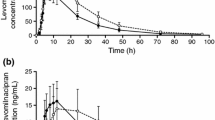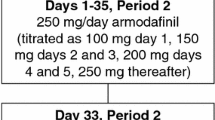Abstract.
Rationale: Despite the fact that carbamazepine (CBZ) is frequently added to the existing tricyclic antidepressant (TCA) therapy, to date little is known about serum levels of pharmacologically active hydroxy metabolites of TCAs, as well as about possible changes in free (non-protein-bound) concentrations of these drugs and their metabolites during such combination treatment of depression. Objective: The aim of this study was to evaluate the effect of CBZ on steady-state total and free serum concentrations of imipramine (IMI) and its metabolites, desipramine (DMI), 2-hydroxyimipramine and 2-hydroxydesipramine, in depressed patients. In addition, the free and total serum concentrations of CBZ and 10,11-epoxycarbamazepine were measured. Method: Thirteen patients with DSM-III-R diagnosis of major depression were enrolled in the study. All patients hospitalised at the Department of Psychiatry, Collegium Medicum, Jagiellonian University were treated with IMI at a dose of 2 mg/kg per day for 3 weeks, after which CBZ at a dose of 400 mg/day was added. Steady-state serum concentrations of IMI, CBZ and their metabolites were assayed by HPLC. Free drug concentrations were measured by ultrafiltration. Results: After 2 weeks of combination therapy a significant decrease in mean steady-state total serum concentrations of IMI (from 168.84±102.18 to 98.12±43.79 ng/ml) and DMI (from 293.89±171.93 to 221.85±153.21 ng/ml) was observed. Simultaneously, steady-state serum concentrations of total hydroxy metabolites and free IMI and its metabolites, measured just before and 2 weeks after CBZ were started, did not differ significantly. In consequence, a significant increase in free fraction of the parent drug was observed (3.36±3.24% vs 5.75±3.60%). Also free fraction of DMI tended to be higher after CBZ addition. Conclusion: CBZ affects not only the metabolism of IMI and its metabolites, but also their protein binding. Therefore, despite considerable reductions in total serum levels of IMI and DMI, but when the unchanged free fraction concentration of these compounds is maintained, a dosage elevation of IMI does not seem to be necessary after CBZ addition to TCA therapy.
Similar content being viewed by others
Author information
Authors and Affiliations
Additional information
Electronic Publication
Rights and permissions
About this article
Cite this article
Szymura-Oleksiak, J., Wyska, E. & Wasieczko, A. Pharmacokinetic interaction between imipramine and carbamazepine in patients with major depression. Psychopharmacology 154, 38–42 (2001). https://doi.org/10.1007/s002130000612
Received:
Accepted:
Issue Date:
DOI: https://doi.org/10.1007/s002130000612




